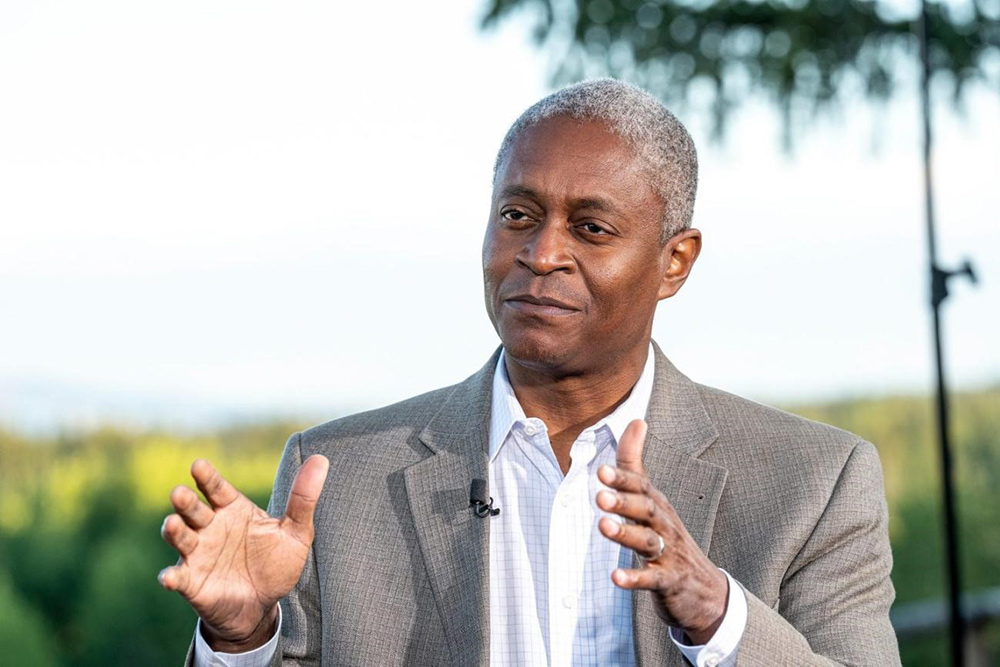
美联储从2022年初以来10次加息以遏制物价上涨,但通货膨胀率仍然居高不下。在本月早些时候的最近一次加息中,美联储暗示可能会暂停加息。
但现在,亚特兰大联邦储备银行行长博斯蒂克认为短期内不会降息。事实上,降息可能要等到2024年。
博斯蒂克周一在接受美国全国广播公司财经频道(CNBC)的《财经论谈》(Squawk Box)节目采访时表示:“我的基线案例(利用牛津模式所做的预测,条件是未对任何变量施加冲击)是,在2024年之前,我们不会真正考虑降息。在我看来,通胀不会那么快回落,因此,降息并不真正适合这种情况。”
亚特兰大联邦储备银行行长表示,即使在美联储内部,关于加息对经济的影响有多严重的争论也在持续。不过,就目前而言,这些数据可能表明,对抗通胀的时间可能比许多人意识到的要长。
博斯蒂克表示:“我们所看到的情况是,通胀率一直居高不下,消费者在支出方面非常有弹性,劳动力市场仍然非常紧张。所有这些都表明,价格仍将面临上行压力。”
他指出,一系列加息已将通胀率从6月份9.1%的40年高点降至上个月的4.9%。尽管通胀率呈下降趋势,但仍远高于美联储2%的目标。
博斯蒂克表示:“如果你看看大多数通胀指标,就会发现目前的通胀率仍然是美联储目标水平的两倍。所以还有很长的路要走。”他还补充说他对美联储未来几个月的建议是“上调”利率。
博斯蒂克的鹰派言论是在美联储暗示可能停止激进加息的几周后发表的。许多投资者曾希望美联储停止加息,这一点已在股市中反映出来。一些专家担心,加息会使经济增长放缓,从而导致经济衰退。其他人则表示,即使通胀降温,降息也不会很快到来。但博斯蒂克认为,即使出现衰退,加息也可能继续。
这位亚特兰大联邦储备银行行长已经明确表示,只要通胀处于高位,美联储就必须坚持加息路线。今年1月,对美联储政策没有投票权的博斯蒂克表示,美联储官员必须在抗击通胀的斗争中“坚持到底”,他说,加息将消除经济中的过度需求。
2月,在美联储加息后,博斯蒂克对彭博社表示:“我们的首要任务无疑是控制通胀。我将尽我所能确保我们做到这一点。”
博斯蒂克说,他的观点取决于经济数据,比如经济数据是指向经济增长强劲还是降温。
降息受到许多专家的支持,他们认为通货膨胀已基本得到控制。宾夕法尼亚大学沃顿商学院(University of Pennsylvania’s Wharton School of Business)的金融专家杰里米•西格尔(Jeremy Siegel)说,在经历了动荡的2022年之后,如果美联储降息,今年股市的回报率可能会上涨15%或更多。但西格尔表示,如果美联储不降息,未来的道路可能会更加艰难。
除了通胀,美联储还面临着其他一些挑战,包括银行贷款活动放缓带来的潜在信贷紧缩,以及2023年前几个月的一系列银行倒闭事件。此外,它还必须应对当前的债务上限危机。在这场危机中,白宫和国会尚未就美国政府为履行其财政义务所能借入的资金上限达成一致。
纽约联邦储备银行(New York Fed)行长约翰·威廉姆斯(John Williams)本月早些时候表示,他将密切关注银行业问题对美国经济的影响,并表示今年不会降息。
据彭博社报道,威廉姆斯表示:“在我的基准预测中,我没发现今年有任何理由降息。”(财富中文网)
译者:中慧言-王芳
亚特兰大联邦储备银行(Atlanta Fed)行长拉斐尔·博斯蒂克(Raphael Bostic)认为,美联储直到“2024年”才会降息。
美联储从2022年初以来10次加息以遏制物价上涨,但通货膨胀率仍然居高不下。在本月早些时候的最近一次加息中,美联储暗示可能会暂停加息。
但现在,亚特兰大联邦储备银行行长博斯蒂克认为短期内不会降息。事实上,降息可能要等到2024年。
博斯蒂克周一在接受美国全国广播公司财经频道(CNBC)的《财经论谈》(Squawk Box)节目采访时表示:“我的基线案例(利用牛津模式所做的预测,条件是未对任何变量施加冲击)是,在2024年之前,我们不会真正考虑降息。在我看来,通胀不会那么快回落,因此,降息并不真正适合这种情况。”
亚特兰大联邦储备银行行长表示,即使在美联储内部,关于加息对经济的影响有多严重的争论也在持续。不过,就目前而言,这些数据可能表明,对抗通胀的时间可能比许多人意识到的要长。
博斯蒂克表示:“我们所看到的情况是,通胀率一直居高不下,消费者在支出方面非常有弹性,劳动力市场仍然非常紧张。所有这些都表明,价格仍将面临上行压力。”
他指出,一系列加息已将通胀率从6月份9.1%的40年高点降至上个月的4.9%。尽管通胀率呈下降趋势,但仍远高于美联储2%的目标。
博斯蒂克表示:“如果你看看大多数通胀指标,就会发现目前的通胀率仍然是美联储目标水平的两倍。所以还有很长的路要走。”他还补充说他对美联储未来几个月的建议是“上调”利率。
博斯蒂克的鹰派言论是在美联储暗示可能停止激进加息的几周后发表的。许多投资者曾希望美联储停止加息,这一点已在股市中反映出来。一些专家担心,加息会使经济增长放缓,从而导致经济衰退。其他人则表示,即使通胀降温,降息也不会很快到来。但博斯蒂克认为,即使出现衰退,加息也可能继续。
这位亚特兰大联邦储备银行行长已经明确表示,只要通胀处于高位,美联储就必须坚持加息路线。今年1月,对美联储政策没有投票权的博斯蒂克表示,美联储官员必须在抗击通胀的斗争中“坚持到底”,他说,加息将消除经济中的过度需求。
2月,在美联储加息后,博斯蒂克对彭博社表示:“我们的首要任务无疑是控制通胀。我将尽我所能确保我们做到这一点。”
博斯蒂克说,他的观点取决于经济数据,比如经济数据是指向经济增长强劲还是降温。
降息受到许多专家的支持,他们认为通货膨胀已基本得到控制。宾夕法尼亚大学沃顿商学院(University of Pennsylvania’s Wharton School of Business)的金融专家杰里米•西格尔(Jeremy Siegel)说,在经历了动荡的2022年之后,如果美联储降息,今年股市的回报率可能会上涨15%或更多。但西格尔表示,如果美联储不降息,未来的道路可能会更加艰难。
除了通胀,美联储还面临着其他一些挑战,包括银行贷款活动放缓带来的潜在信贷紧缩,以及2023年前几个月的一系列银行倒闭事件。此外,它还必须应对当前的债务上限危机。在这场危机中,白宫和国会尚未就美国政府为履行其财政义务所能借入的资金上限达成一致。
纽约联邦储备银行(New York Fed)行长约翰·威廉姆斯(John Williams)本月早些时候表示,他将密切关注银行业问题对美国经济的影响,并表示今年不会降息。
据彭博社报道,威廉姆斯表示:“在我的基准预测中,我没发现今年有任何理由降息。”(财富中文网)
译者:中慧言-王芳
Raphael Bostic, Atlanta Fed President, doesn't see rate cuts till "well into 2024."
DAVID PAUL MORRIS—BLOOMBERG/GETTY IMAGES
Inflation remains high even after the Federal Reserve hiked interest rates 10 times since early 2022 to curb rising prices. In its most recent increase earlier this month, the central bank hinted at possibly suspending the increases.
But now, Atlanta Fed President Raphael Bostic thinks that rate cuts won’t happen anytime soon. In fact, it could take until 2024.
“My baseline case is we won’t be really thinking about cutting till well into 2024,” Bostic told CNBC’s Squawk Box in an interview Monday. “In my world, inflation doesn’t come down that quickly and in that regard, cutting rates doesn’t really fit into that scenario.”
The Atlanta Fed chief said that even within the Fed, there is an ongoing debate about how harsh the impact of rate increases could be on the economy. For now, though, the data may point to a lengthier battle against inflation than many realize.
“What we’ve seen is inflation has been persistently high, consumers have been really resilient in terms of their spending and labor markets remain extremely tight. All of those suggest that there’s still going to be upward pressure on prices,” Bostic said.
He noted that the series of rate hikes have reduced inflation from a 40-year high of 9.1% in June, to 4.9% last month. But despite the downward trend, the inflation rate is far higher than the Fed’s goal of 2%.
“If you look at most measures of inflation, that’s still two times where our target is. So there’s a long distance still to go,” Bostic said, adding that his advice for the Fed in the coming months would be to “go up” with rates.
Bostic’s hawkish remarks come just weeks after the Fed indicated it may halt its aggressive rate hikes, which many investors had hoped for and have priced into the stock market. Some experts are worried about the rate hikes causing a recession by slowing the economy’s growth. Others have said that even as inflation cools, interest rate cuts won’t come quickly. But Bostic argues that interest rate increases may continue even if there’s a recession.
The Atlanta Fed President has been clear about his view that the Fed must stay the course when it comes to rate hikes as long as inflation is high. In January, Bostic, who doesn’t vote on Fed’s policy this year, said that central bank officials must “hold our resolve” in the battle against inflation, saying that a higher rate will eliminate excessive demand in the economy.
“Job one for us has got to be to get inflation back under control,” Bostic told Bloomberg in February, following one of the Fed’s rate hikes. “And I’m going to do all I can to see that we do that.”
Bostic said his view is informed by economic data, such as whether it points at a robust or cooling economy.
A rate decrease is favored by many experts who feel like inflation has been largely brought under control. Jeremy Siegel, a financial profession at University of Pennsylvania’s Wharton School of Business, said that stock market returns could jump 15% or more this year if the Fed cuts rates, following a tumultuous 2022. But if the Fed doesn’t slash interest rates, the path ahead could be tougher, Siegel said.
The Fed faces a few other challenges along with inflation, including a potential credit crunch amid slower lending activity at banks as well as a series of bank failures in the first few months of 2023. Additionally, it must contend with the current debt ceiling crisis, in which the White House and Congress haven’t agreed yet on a cap for the amount of money the U.S. government can borrow to meet its financial obligations.
New York Fed President John Williams said earlier this month that he’ll be watching how the banking sector’s troubles affect the U.S. economy, and steered away from reducing interest rates this year.
“I do not see in my baseline forecast any reason to cut interest rates this year,” Williams said, according to Bloomberg.






